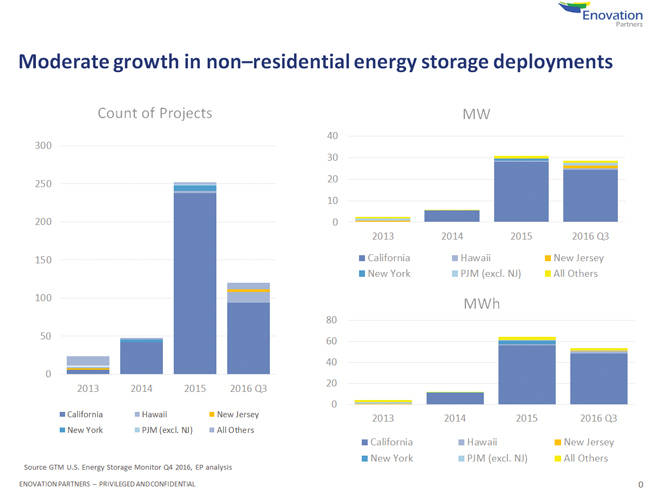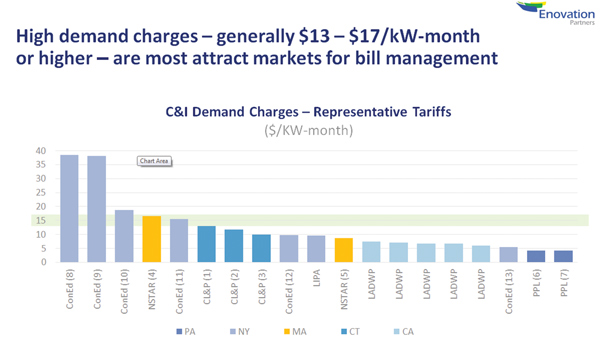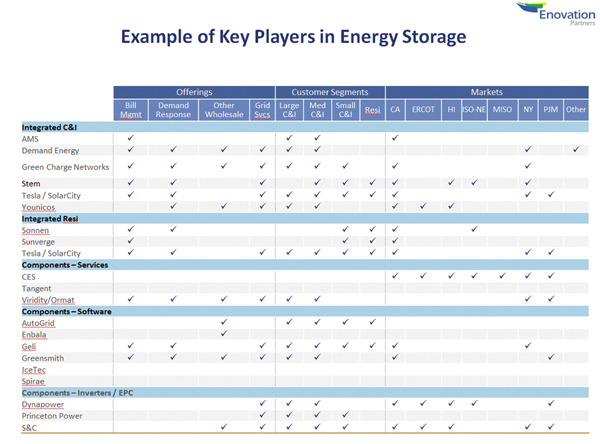What You Need to Know About Energy Storage
Common Misconceptions, How to Assess Options, Practical Operational Concerns, and Where's the value?
By Rajan Chudgar and Dan Gabaldon
There is a reason for the seemingly endless series of conferences and press releases on energy storage, and why the topic is near the top of the agenda for many energy and facility managers across the country. In the last three years, more energy storage has been deployed in the U.S. than the previous five years combined
 |
| Convergent Energy + Power worked with Central Maine Power to install a 3-MWh battery asset engineered by Lockheed Martin. A single energy storage system can yield multiple, complementary sources of value, known as "value stacking." Photo courtesy: Convergent Energy + |
This growth has been fueled by a 50 percent decrease in storage system costs over the last two years, combined with ample regulatory support at the state, regional, and federal level, as well as an explosion of commercial activity by start-up and more established energy storage system developers.

The potential benefits for commercial and industrial facilities are significant and multiple. The most common application of behind the meter (BTM) energy storage systems today is to reduce demand charges.
They can also be used to participate in demand response programs, saving facilities the need to respond to load curtailment events with reductions in facility activities, or relying on - increasingly environmentally challenged - diesel-fired back-up generation units. Others employ energy storage systems to reduce process wastes due to "unclean" power, and eliminate bothersome momentary power losses that cause industrial process control systems to reset. With growing momentum in many states to reduce the value of exports of excess PV production (i.e., net metering) and to boost demand charges, energy storage systems are increasingly being paired with PV systems to maximize their value and protect the investment from changing regulatory regimes. Energy storage systems can assist utilities in stabilizing severe grid issues that could create sustained power outages. And this list doesn't begin to exhaust the sources of value from energy storage that commercial and industrial users are exploring. Perhaps most intriguing, advances in energy storage system software enables the capture of multiple sources of value (known as "value stacking") from a single installation.
This in a nutshell is the promise and challenge of energy storage. It is a highly flexible tool for addressing a multitude of economic and operational issues, but it is complex and rapidly evolving. How should energy and facility managers act to start taking advantage of this new resource?

The term itself requires a bit of explanation. Energy storage, in general, is defined as the ability to store energy using thermal (e.g., chillers), electro-mechanical (e.g. Flywheels) or electro-chemical (e.g. Li-Ion batteries) solutions. While thermal and electro-mechanical solutions can be a good fit for a some applications, the industry buzz and growth is primarily due to rapid technical and economic advances in electro-chemical systems, which in turn are being propelled by developments in the transportation and computer hardware sectors. Within the electro-chemical space there are a large number of chemistries, each with pros and cons with respect to parameters such as capacity, discharge duration, energy density, ("roundtrip") efficiency, ability to cycle without deteriorating system efficiency and capacity, safety and environmental risks, and overall cost for a given application.
Currently, the most widely applied chemistries are Lithium Ion, Zn, Vn, and sodium.
Not surprisingly, given the combination of a profusion of rapidly advancing technologies, applied to rapidly evolving set of overlapping and complementary use cases, the potential for confusion is high! Where to start? How much are the real costs? Should one buy, lease, enter into a PPA or explore some other structure for procuring an energy storage system? Is best to buy components and integrate them oneself or buy an already fully configured system? Which single or combined applications make sense for your facility, and what are the financial paybacks? Are there subsidies that one can apply to reduce the cost of energy storage? What are the operating and commercial risks? What types of warranties and insurance products are available, and at what price? What are the practical implications for permitting and installing a unit? How will it interact with existing energy/building management systems? Who are the market leaders in energy storage?

How to get started?
Many experts like to compare energy storage to a Swiss Army knife. It can do lots of different things, so the place to get started is to understand how your underlying energy management needs map on to its range of capabilities. One can bundle the various services energy storage is capable of providing into four basic sets use cases:
- Economic value: The energy storage solution is going to drive down my overall electric costs. This may be realized by some combination of reducing peak demand, shifting load over time, or increase my revenue by enabling me to participate in demand response or other wholesale market programs. The magnitude and mix of these different value streams will naturally depend on where your facilities are located and the applicable tariffs and wholesale power programs in which you can participate and your load shape, including integrating other distributed energy resources available to your facility (behavioral or automatic load reduction, fossil-fired or PV distributed generation, etc.)
- Reliability value: The energy storage solution is going to reduce potential brownouts and/or blackouts and be a bridge to potentially other generation sources for long term outages
- Power Quality value: The energy storage solution is helping with voltage, frequency or other dynamic power quality problems that are causing damage to my systems or processes
- Green value: The energy storage system complements other green solutions (e.g. solar or wind) to increase the value of the "green" system - such as enabling you to store excess on-site power production for use during other times of the day, or to times when you can "clip" high cost demand charges or offset high time-of-use prices for grid supplied energy - and further reduce my carbon footprint.
Note that in many cases a single energy storage system can yield multiple, complementary sources of value, known as "value stacking." Storage systems can use smart software packages to enable a system to provide multiple sources of revenues and savings, while also providing the user enhanced reliability.

Once you have determined your primary use case, the next steps naturally including configuring the right system to address that use case, deciding how to contract for the energy solution, and perhaps most simply and essentially, finding the right team - or teams - to work with to design, install, and possibly operate and finance your system. Here are some simple lesson learned and tips you should consider as you move forward in your energy storage adventure:
System configuration: The most fundamental issues include understanding how much peak power capacity you want to be able to store, how long you need the battery to discharge, and the number of times it will need to "cycle" (from charge to discharge) over the course of its life. In general, today energy storage is most economical for discharge periods of four hours or less.
Be sure you understand how your electric bill and potential revenues will respond to how you actually plan to use the system, today and into the future. Do take into account the full costs of actually installing the unit, including seemingly mundane items like the cost of the housing of the storage unit and the potential cost of changes to the local distribution system. Understanding the implications of adding for your existing building management system and other forms of distributed energy resources (PV, back-up generation and UPS, automatic demand response systems, etc.) is also critical to getting the design right for capturing maximum value and minimizing risk. And most energy storage users are well aware of how critical is to get the software solution for the system right, including ensuring it provides the level of load and market forecasting, as well as integrating storage with your load and other DER equipment to optimize value.
Additional practical considerations may include, size and weight, safety factors, subsidies, your current and expected electricity rate and structure, warranties and performance guarantees. As Enovation Partners and Lazard have illustrated in great detail with their "Levelized Cost of Storage" studies, specifying exactly what kind of capabilities you desire for your energy storage system can have a material impact on the cost and investment return you can expect

Ownership options: As in the case of PV and other energy assets, there are a wealth of options for accessing energy storage. Do you want to own, lease, or get a performance contract? Each of these options will have a relationship to the key use cases and your appetite for different types of risks and rewards. For example, large and sophisticated users with abundant and low cost capital may prefer to own the energy storage unit outright, while others may prefer the convenience of employing a Power Purchase Agreement (PPA) as they do with PV installations, while others may prefer a shared or guaranteed savings contract, similar to the approach taken to funding energy efficiency programs Keep in mind the primary use case for you should always be the key performance characteristic for any ownership option.
Supplier choice: The downside of participating in a vibrant, rapidly advancing field like energy storage is that the field vendors and solutions providers are rapidly changing, with often limited and/or hard to compare track records and claims of expertise. Finding the energy storage solution and vendor that best suits your needs - including your needs for financing and addressing different commercial risks - requires more than simple price comparison. The technology is new, so it's more critical to find the right people - with practical, real experience with energy storage - than relying on otherwise familiar name brands. It pays to do a bit of "homework" on the team to understand the applicability of their experience to your situation; different markets/use cases require different skills and experience. Get a clear understanding of the range and level of responsiveness to issues you can expect from them, and the depth of capabilities (operations, dispatch, design, financing, degree of integration required) they will bring to you. And do not hesitate to check references!

Contracting: Even though the industry is new, you should expect increasingly robust insurance and warranty options, with critical terms now much better - though still imperfectly - defined and priced. If financing is important for you, keep "bankability" on warranties in mind; be sure you understand the technical, regulatory, merchant risks you're taking. There is also a growing array of specialized service providers with whom you can contract to provide services like testing, unit dispatch, and maintenance should you choose to outsource these services.
Don't let the complexity put you off. Energy storage is rapidly becoming a standard element of the energy management planning tool kit. While it will require some initial investment to understand the technological and commercial basics, we believe it will be well worth the effort.
Authors
Rajan Chudgar is president of Viridity Energy. Dan Gabaldon is
managing director of Enovation Partners.
Copyright © 2017: PennWell Corporation Subscribe to http://www.power-eng.com